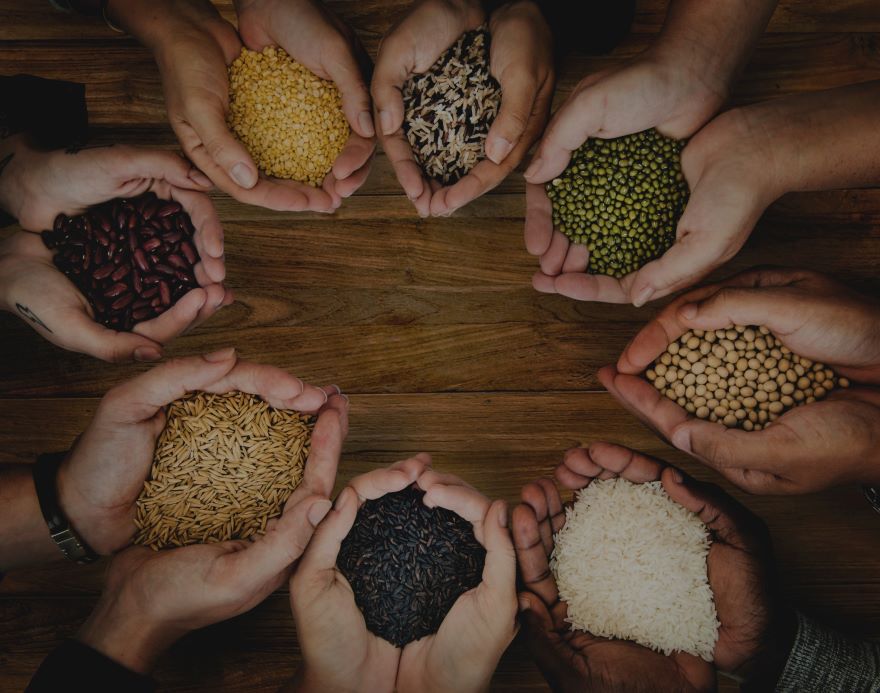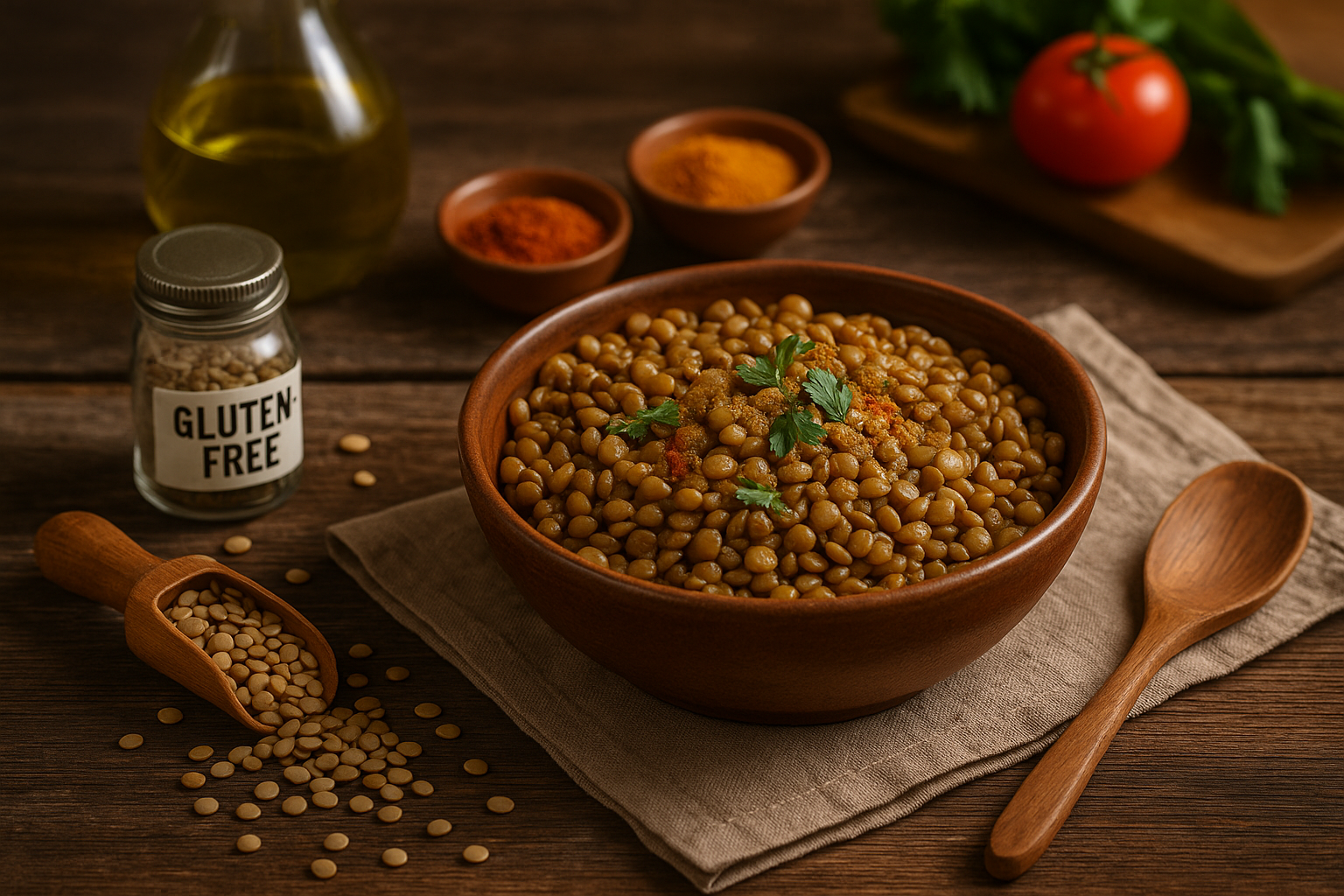Pre-cooked lentils are a convenient and versatile ingredient for those looking to add more plant-based protein to their diet. Pre-cooked lentils suit busy individuals who want a quick, healthy meal option. They come in various types and provide protein, fiber, iron, and manganese in a wide array of dishes.
Pre-cooked lentils save cooking time without sacrificing taste or nutrition. Use pre-cooked lentils in salads, soups, stews, and bowls. No soaking or cooking required, unlike dried lentils. The lentils’ consistent texture and shape make them practical for uniform dishes.
Key Takeaways
- Pre-cooked lentils offer convenience, saving time in the kitchen.
- They provide a good source of plant-based protein and essential nutrients.
- Use pre-cooked lentils in various dishes, from salads to stews.
What Are Pre-Cooked Lentils
Cooks can save time and effort by using pre-cooked lentils, which are lentils that are cooked before packaging. You only need to heat them and incorporate them into your meals. They are a great option if you’re short on time, as they are easier to prepare than traditional dry lentils that require a longer cooking time. Here’s a closer look at lentil varieties and their place in the legumes and pulses family.
Lentil Varieties
You can also find pre-cooked lentils in a variety of types. Some of the common varieties include:
- Green Lentils: Known for their slightly peppery flavor, green lentils hold their shape well after cooking, making them perfect for salads and side dishes.
- Brown Lentils: These are the most common type of lentils. Their mild, earthy flavor makes them versatile in various dishes.
- Red Lentils: Red lentils have a sweet and nutty flavor, and they tend to become mushy when cooked. This makes them perfect for soups, stews, and Indian dishes like dals.
- Yellow Lentils: Similar to red lentils, yellow lentils have a mild flavor and cook quickly, making them ideal for purees, soups, and stews.
Legumes and Pulses
Lentils are part of the legume family, which includes beans, peas, and peanuts. Legumes are plants that bear fruit enclosed in pods, and they are a significant source of protein, fiber, and other essential nutrients. Pulses, on the other hand, are a subgroup of legumes and include only the dried, edible seeds of these plants. Lentils, being both a legume and a pulse, are a staple in many cuisines around the world, offering a versatile and nutritious addition to my meals. With pre-cooked lentils, you can enjoy these benefits in a more convenient and accessible way.
Benefits of Pre-Cooked Lentils
Nutrient Content
I am always on the lookout for plant-based protein options. Pre-cooked lentils are one of my favorites, as they are not only convenient but also nutritionally dense. Pre-cooked lentils are an excellent source of protein, with 12 grams of protein in just half a cup.
Besides their protein content, lentils are rich in essential minerals like iron and potassium, which contribute to overall health. Iron is crucial for carrying oxygen throughout the body, while potassium helps maintain healthy blood pressure levels. In addition, lentils contain a substantial amount of fiber, which stabilizes blood sugar, lowers cholesterol, and improves digestion. A single serving of lentils contains over 3 grams of fiber.
Convenience
Busy individuals appreciate the convenience of lentils, which are already prepared and just need to be heated or added to a dish. While canned lentils can be used, rinsing them before use is always a good idea to remove any excess sodium.
You can incorporate pre-cooked lentils into various meals, such as salads, soups, and stews, as they are versatile. They make an ideal addition to my vegan diet while saving me time and effort in the kitchen. Plus, the convenience of pre-cooked lentils helps me maintain a healthy, balanced lifestyle without added stress.
How to Use Pre-Cooked Lentils
In Soups
I find pre-cooked lentils to be a great addition to my homemade soups. They provide a hearty and protein-packed element. To make soups even richer, I usually add pre-cooked lentils to my favorite vegetable or tomato-based soup recipes. I often mix in the lentils during the last few minutes of simmering to ensure that they don’t become mushy, and they maintain their texture.
In Salads
Incorporating pre-cooked lentils into salads is an excellent way to elevate both the texture and nutritional value of my dishes. To do this, I simply toss the lentils with some chopped vegetables like cucumbers, tomatoes, or bell peppers, creating a satisfying and tasty meal. Adding a tangy dressing with lemon juice or vinegar can really bring out the flavors in my lentil salads.
In Veggie Burgers
When I’m craving a meat-free burger option, I rely on pre-cooked lentils to make delicious veggie burgers. By adding these legumes to mashed beans and cooked vegetables, I create a mixture that binds well when shaped into patties. To make the burgers even more flavorful, I like to experiment with different seasonings and spices. After forming the patties, I cook them in a saucepan or an oven to achieve a crispy outer layer.
As Side Dishes
Pre-cooked lentils make an incredible and easy side dish. I often sauté them with some olive oil, garlic, and onions, then add a bit of vegetable broth and let it simmer for a few minutes. Sometimes, I also toss in some herbs and spices for extra flavor. Serving the lentils as a side dish alongside roast vegetables or grilled meats can make a fantastic, wholesome meal.
In Dips
One of my favorite ways to use lentils involves turning them into delicious and healthy dips. I blend lentils with ingredients like tahini, lemon juice, and garlic to create a unique twist on traditional hummus. And if I want to create a creamier texture, I mix in Greek yogurt or sour cream. Serving lentil dips with toasted pita, fresh veggies, or baked chips is perfect for parties or simply for a nutritious snack.
In summary, pre-cooked lentils are incredibly versatile ingredients that can enhance a variety of recipes. From adding nutrition to soups and salads, to creating meatless burgers and flavorful dips, these legumes are truly indispensable in my kitchen.
Tips for Cooking With Pre-Cooked Lentils
As a lentil lover, I have some advice on how to handle pre-cooked lentils and make the most out of them. Pre-cooked lentils can be a real time-saver without compromising on flavor or nutrition.
First, when I reheat pre-cooked lentils, I typically place them in a saucepan with a bit of water, vegetable broth, or cooking liquid from when they were first cooked. This helps maintain their texture and prevents them from drying out. I bring the liquid to a simmer and let them warm up over low to medium heat for about 5-7 minutes.
One of the benefits of pre-cooked lentils is that they come in various forms and are ready to add to various dishes. Knowing the cook times of different lentil types is essential, as green/brown lentils take 20-30 minutes, French and black lentils need 25-30 minutes, while red lentils cook in just 12-15 minutes. Since lentils have already been through this process, I don’t have to worry about cook times.
For a quick and simple meal, I love to take my pre-cooked lentils and toss them in a salad. They can add protein and a hearty texture, making my salads more satisfying. Another option is to mix them into soups or stews, knowing that they will hold their shape without becoming too mushy.
I also enjoy using pre-cooked lentils in more creative recipes, such as incorporating them into curry dishes or making a delicious lentil-based dal. Combining the lentils with aromatic spices and vegetables can create a tasty, healthy, and effortless meal.
In conclusion, working with pre-cooked lentils can make life much easier for me. Whether I’m using them in a simple salad or transforming them into a scrumptious curry or dal dish, I appreciate how convenient lentils are. They remain a valuable addition to my kitchen.
Storing Pre-Cooked Lentils
I find that storing pre-cooked lentils properly can help maintain their freshness, texture, and taste. To ensure that the lentils last for a longer period, it is essential to follow the suitable storage methods mentioned below.
Firstly, I allow the cooked lentils to cool completely before storing them. Hot lentils can create condensation inside the storage container, leading to moisture buildup and spoilage. Once cooled, I choose an airtight container or freezer bag that is suitable for long-term storage. These containers help to prevent any contamination and keep the lentils fresh.
To freeze lentils, I spread them out on a baking sheet and freeze them for 1 to 2 hours until they are thoroughly frozen. This way, the lentils don’t clump together, and it’s easier to portion them out later. After freezing, I transfer the lentils into labeled freezer bags, mentioning the date of storage.
For storing cooked lentils in the refrigerator, I place them in a well-sealed container. The ideal storage temperature for lentils is around 40°F to 60°F (4°C to 15°C). This temperature helps in maintaining their freshness and quality.
When it’s time to reheat the pre-cooked lentils, I make sure to heat them thoroughly, either on the stovetop or in the microwave. This prevents the growth of harmful bacteria and ensures a delicious meal. I always consume the refrigerated lentils within three to five days and the frozen ones within three months to experience their best taste and quality.
Different Types of Lentils
Lentils are a versatile and nutritious legume, enjoyed in many dishes across various cuisines. In this section, we will discuss the different types of lentils, focusing on their unique characteristics and some of their culinary uses.
- Green Lentils: Green lentils have a mild, earthy flavor and hold their shape well when cooked. They are a popular choice for salads and side dishes, as well as a reliable addition to stews, soups, and casseroles. I appreciate their firm texture and the fact that they can be used as a satisfying meat substitute in vegetarian meals.
- Red Lentils: Red lentils are known for their distinctive color and their tendency to break down during cooking, producing a creamy consistency that works well in soups and stews. They’re also an essential ingredient in Indian cuisine, frequently used for making dhal. I find them to be a great way to thicken dishes while adding a rich, slightly sweet flavor.
- Brown Lentils: Brown lentils, like green lentils, maintain their shape when cooked, making them ideal for a variety of uses. Their mild, earthy taste complements a wide range of dishes, from soups and stews to pasta sauces and salads. I appreciate their versatility and often use them as a staple ingredient in my cooking.
- Yellow Lentils: Yellow lentils, similar to red lentils, cook down to a soft and creamy texture. They are particularly popular in Indian and Middle Eastern cuisines. I find them to be a delicious and comforting choice for warm, flavorful meals.
- Black Lentils: Also known as beluga lentils, black lentils are small and have a rich, nuttier taste. They retain their shape when cooked, giving them a pleasant firm texture. I enjoy using them in salads, side dishes, and warm grain bowls for added protein and a touch of sophistication.
- Puy Lentils: Native to the Puy region of France, puy lentils are smaller and darker green than traditional green lentils. They have a unique peppery flavor and remain firm when cooked. I find them to be an excellent choice for salads and side dishes, particularly when paired with robust flavors like goat cheese and tangy vinaigrettes.
- French Green Lentils: French green lentils, sometimes known as du Puy lentils, are a specific variety of green lentils with a slightly firmer texture and a nuttier flavor than regular green lentils. They hold their shape well in cooking, making them a popular choice for dishes like salads, stews, and pilaf. I enjoy incorporating them into my meals for a more distinguished taste and an appealing, toothsome texture.
Conclusion
In my experience, pre-cooked lentils are a convenient and healthy addition to various meals. They are versatile and can be used in multiple dishes, such as salads, soups, and stews. Pre-cooked lentils save time, as they do not require lengthy cooking processes. However, it is crucial to ensure they are cooked correctly to retain their nutritional value and avoid any potential risks associated with undercooked lentils.
One significant advantage of pre-cooked lentils is their high fiber content, with one serving containing about 60% daily fiber requirement. Additionally, they are a good source of protein and essential nutrients like iron and potassium. Lentils are also known for their low-fat content, making them a suitable choice for maintaining a healthy diet.
Incorporating pre-cooked lentils into your meals can also benefit specific health conditions like diabetes. The low-glycemic index of lentils helps in maintaining blood sugar levels, providing a positive effect on those patients.
In the end, I have found that pre-cooked lentils are a cost-effective and easy way to enhance the nutritional quality of my meal options. Whether you opt for canned or frozen varieties, pre-cooked lentils remain a valuable ingredient for those seeking to maintain a balanced diet with minimal effort.
Frequently Asked Questions
- How can I use canned lentils in recipes? Canned lentils are versatile and convenient because they’re already pre-cooked. I can easily use them in a variety of recipes such as salads, soups, stews, or even as a protein-packed addition to rice dishes. To use canned lentils in recipes, simply drain and rinse them well before adding them to your dish.
- What is the best way to prepare steamed lentils? To prepare steamed lentils, I first rinse the lentils thoroughly to remove any dust or debris. Then, I add the lentils to a steamer basket placed over a pot of boiling water. The steaming process usually takes about 20-30 minutes, depending on the type and size of lentils. Steamed lentils are a healthy and delicious side dish, and they can also be used as a base for salads or other recipes.
- Are there different cooking methods for green and red lentils? Yes, there are different cooking methods for green and red lentils. Green lentils are firmer and hold their shape better when cooked, making them ideal for salads and dishes where retaining texture is important. They typically take 20-30 minutes to cook. On the other hand, red lentils cook faster (approximately 15-20 minutes) and tend to become soft and mushy, making them perfect for soups or purées.
- How long is the shelf life of pre-cooked lentils? The shelf life of pre-cooked lentils varies depending on how they are stored. Cooked lentils stored in an airtight container in the refrigerator can last for 5-7 days. For a longer shelf life, I can freeze cooked lentils for up to 3 months. To use frozen lentils, just thaw them in the refrigerator or reheat them directly in a dish.
- Are undercooked lentils safe for consumption? Undercooked lentils can be hard for some individuals to digest, potentially causing stomach discomfort or gas. It is best to avoid consuming crunchy lentils. Instead, ensure they are cooked to a tender and palatable texture before serving.

*We may earn a commission for purchases made using our links. Please see our disclosure to learn more.



